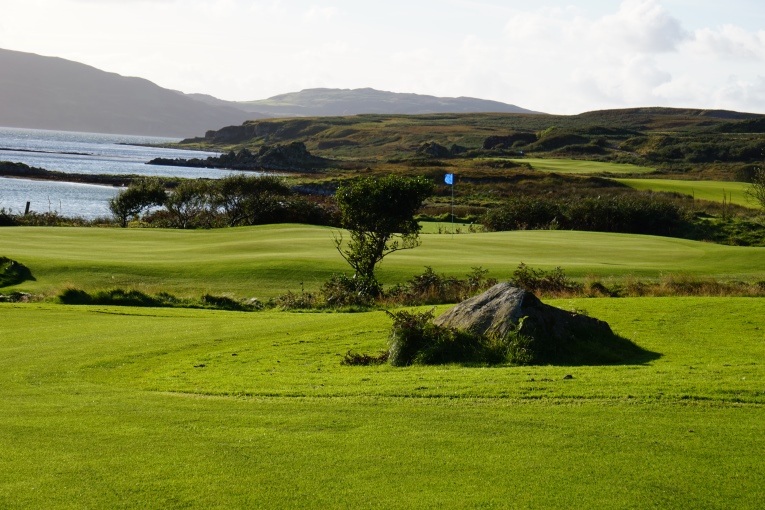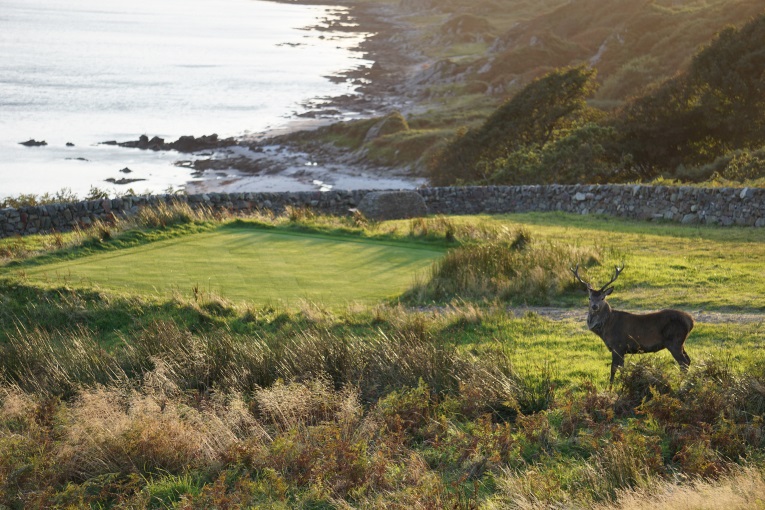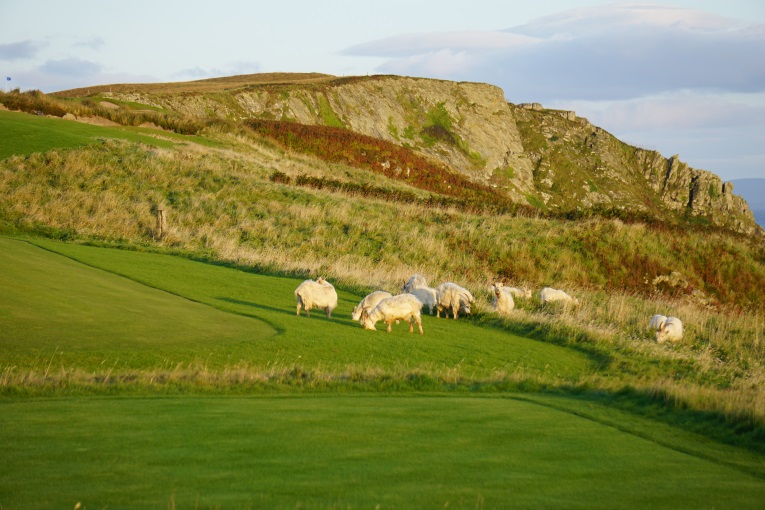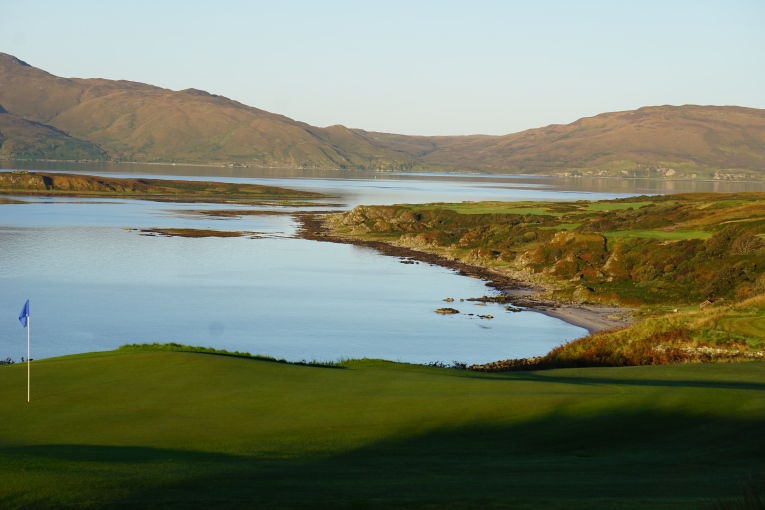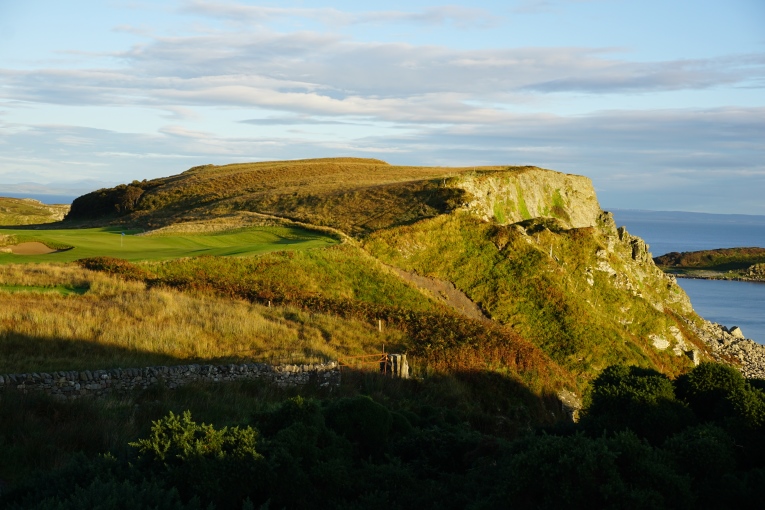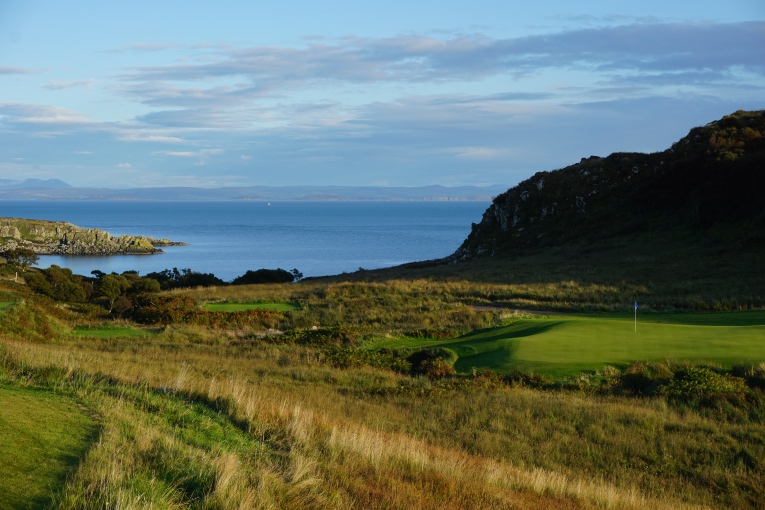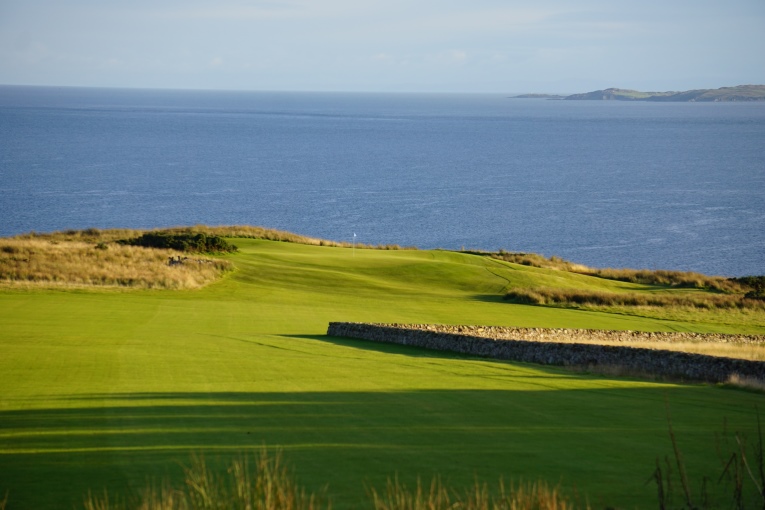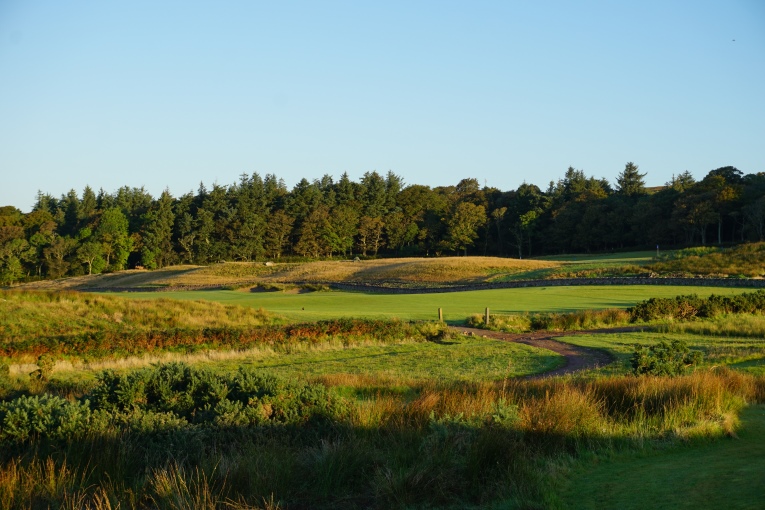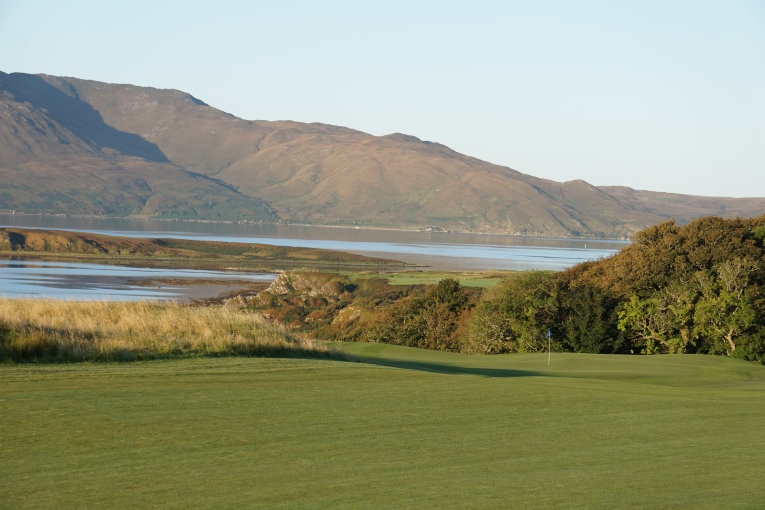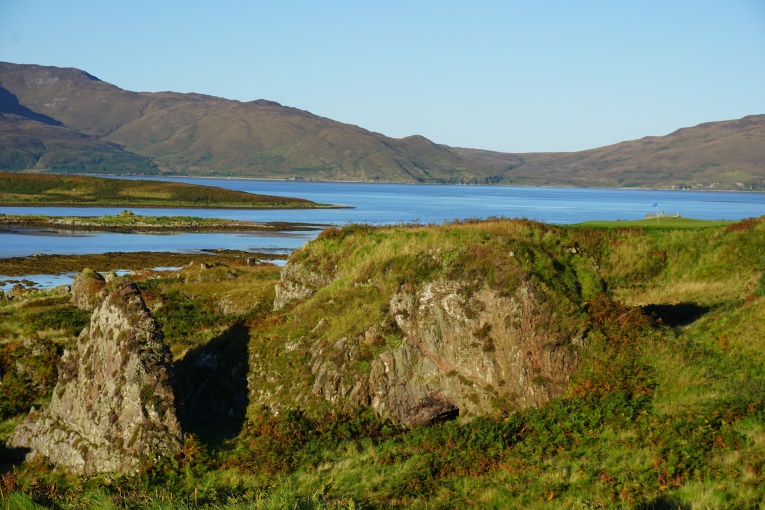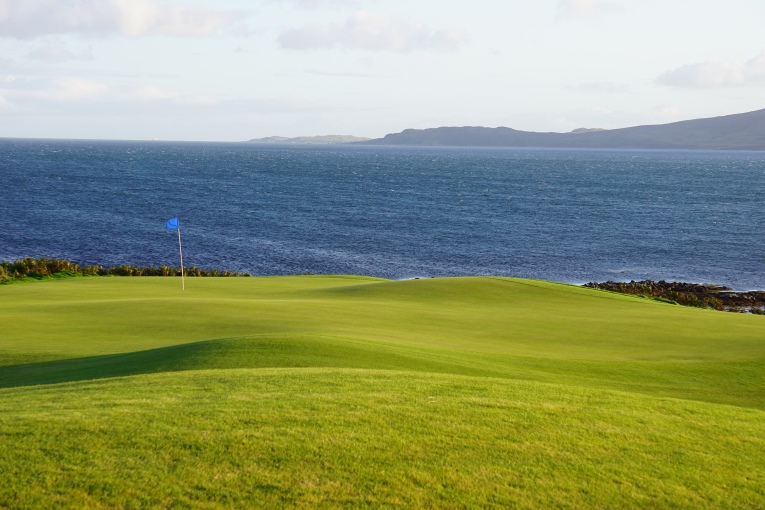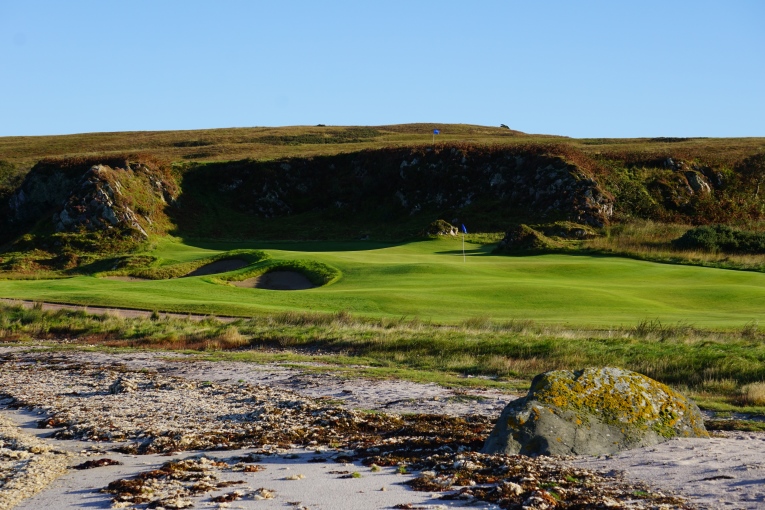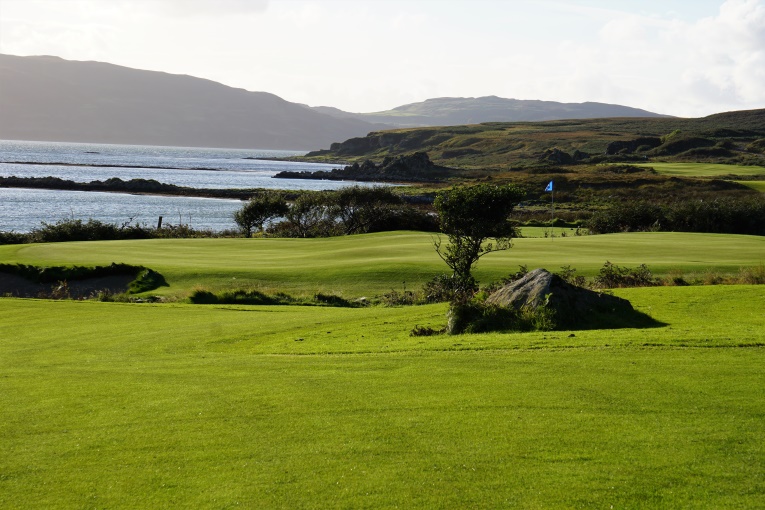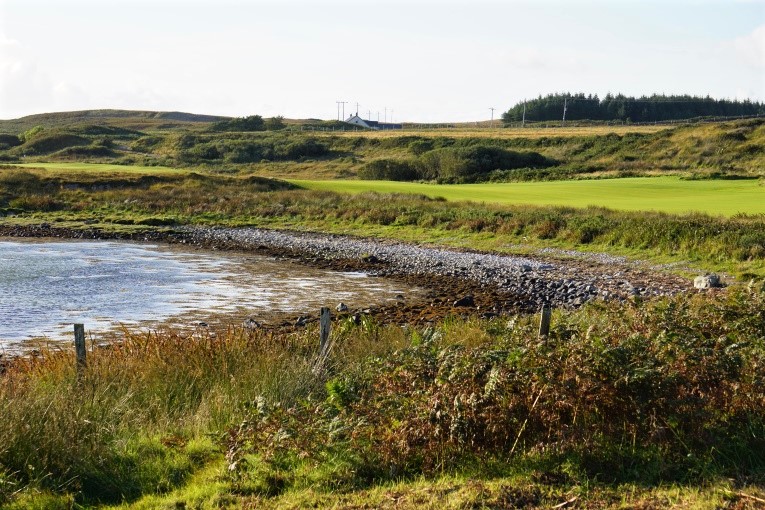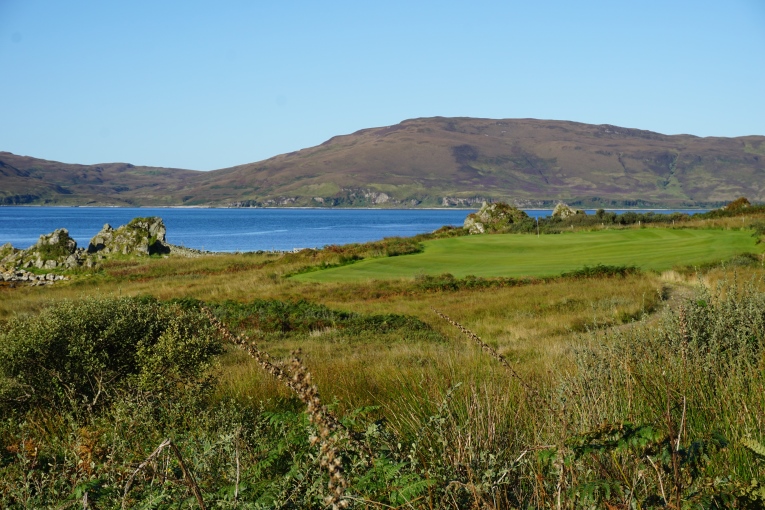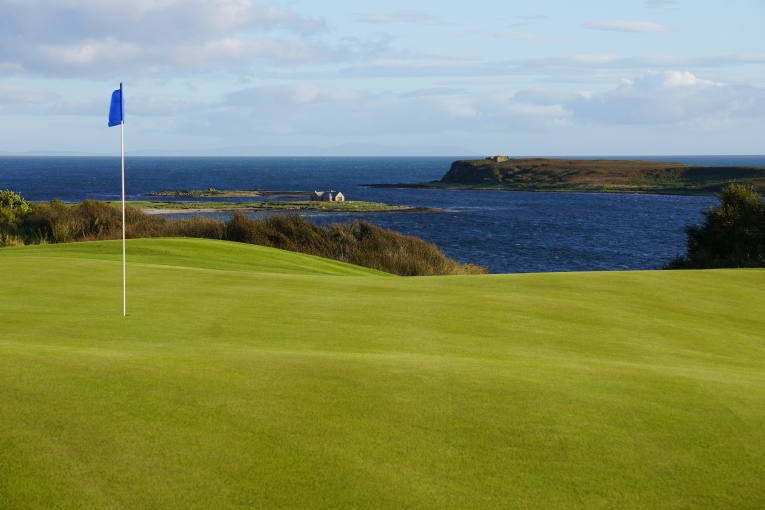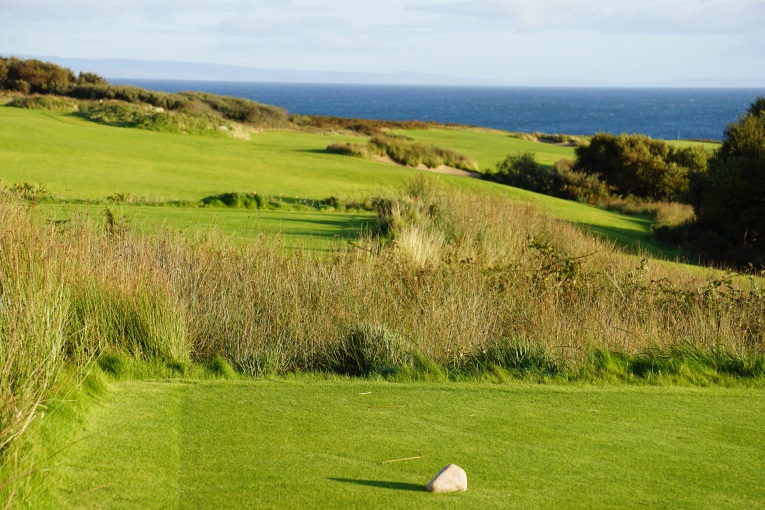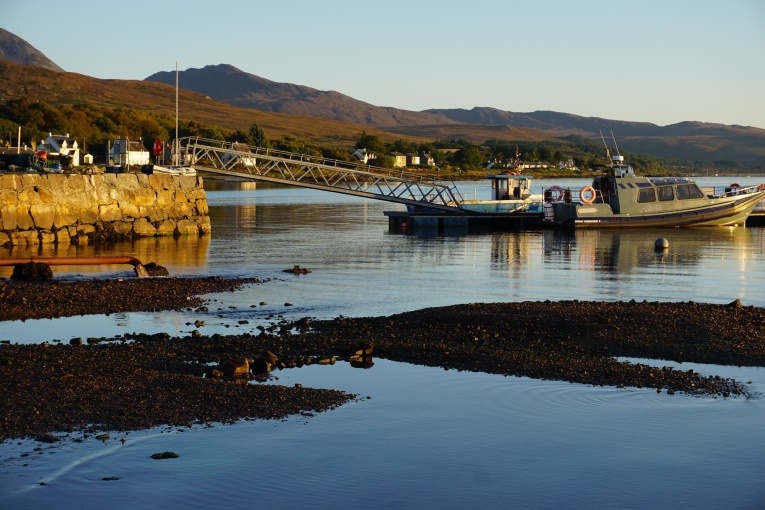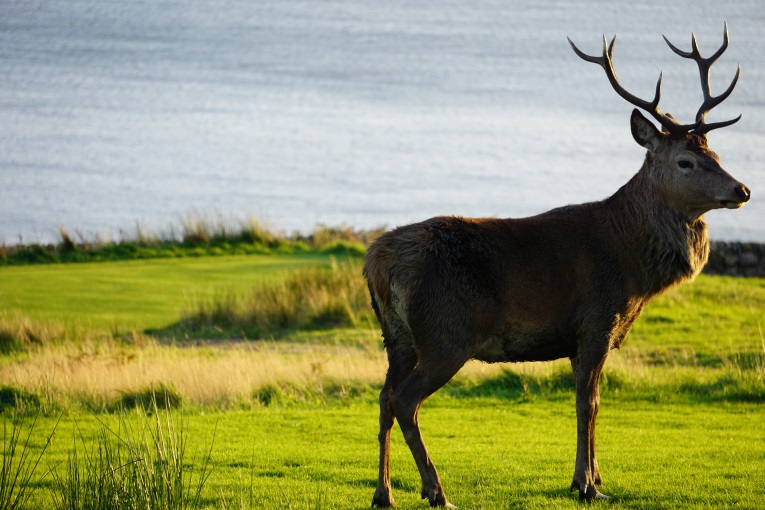Ardfin Golf Course
Isle of Jura, Scotland
United Kingdom
Animal Farm was not written by George Orwell on Jura, which is ironic in that Jura translates from an Old Norse word loosely meaning wild animal. Orwell went to the northeast coast of Jura after World War II to write 1984. Orwell’s cautionary tale might well have been a metaphor for the dreary golf architecture of the 1980s. Parkland ‘championship’ courses dominated and narrow defined tough. Holes were walled off from one another by trees and brush. Developers/owners of golf courses were more interested in selling homes than building great courses. Consequently, new courses were either near population centers or for second homes in gated communities.
Thankfully, Orwell’s vision didn’t fully come to pass and golf architecture eventually entered a second Golden Age period. Backed by visionaries willing to bet on the game’s allure ‘if you build it, they shall come’, courses sprang up in all sorts of thinly populated, romantic places from Tasmania to Nova Scotia. Golf course architect Bob Harrison was part of one such venture when Australia’s wealthiest man decided to build a golf course in the gorgeous rolling hills north of the Hunter Valley. Most architects never experience the freedom of working with a huge swath of land to reveal the best golf with no allowance made for economic outcomes like homesites. Certainly, only a handful ever get the chance twice. So, imagine Harrison’s surprise when he received a phone inquiry late one night in August, 2011 if he would be interested in building a course on the Isle of Jura in the Inner Hebrides. Bob’s natural reaction? Which mate was pulling a prank! When later that night Harrison told his wife, Colette, that he wasn’t sure he could do such a remote project justice, she told him to get straight back in touch with Jura and ‘get on with it pronto.’
After an email the next day from Australian financier Greg Coffey, things became very real. Five days later, Harrison was on a plane making the thirty hour journey from Sydney, Australia to the Isle of Jura. He moved quickly not only at his wife insistence (!) but because he thought this could be a match made in heaven. Harrison had visited the Isle of Islay next to Jura for over twenty years, specifically to play the Machrie. In preparing Harrison’s April 2000 Feature Interview on this site, the author was surprised that Harrison nominated Machrie as one of his top five courses in Scotland. Additionally, Harrison knew Coffey to be a direct man who spoke his mind in clear terms. In short, the ideal client.
As the above photograph illustrates, golf on a remote Scottish isle is broadly the stuff of dreams. The view of the 16th century Claig Castle, Sound of Islay and the blue flag on the eleventh green standing at attention convey a new paradigm of beauty for golf. Yet, the practical side of fashioning a course that both pays respect to the wind swept, rocky landscape and allows players of most abilities to have fun is no small task. Willie Macdonald, the Estate Manager, oversees Coffey’s 15,000 acres. Macdonald grew up on the isle and as a man much in demand to lead stag stalking parties, no one knows the land better. Macdonald would serve as Harrison’s guide and companion when they explored the estate. While the soil lacked a sandy loam component, the environment was otherwise most handsome. Fescues, heather and gorse abounded amid the sylvan oak, birch, bog willow and hazel.
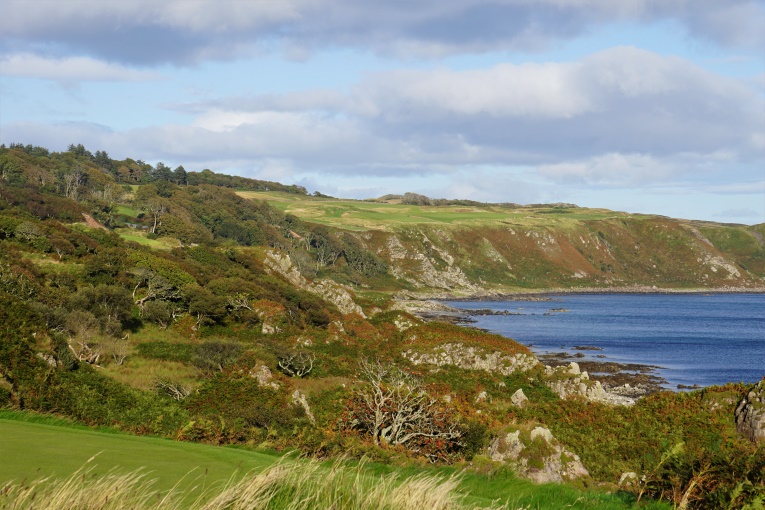
Though Jura’s soil is largely infertile, it yields a number of strains of vegetation and trees that provide a panoply of colors and texture. This view is southeast toward the higher first seven holes.
Though one would not know it today, the process of building the course was quite arduous. Harrison turned to Sol Construction who did a magnificent job. In retrospect it was very fortunate that unabated, torrential rains hit the Isle during course construction, foretelling the sort of weather that the course would need to handle. Great golf does not exist without proper water management. Harrison details:
We received an atrocious amount of rain during the summers of both 2015 and 2016, substantially slowing the construction process. It seemed never-ending, and it also made tasks like shaping the difficult ground even more difficult – particularly if we had to finish areas when the ground conditions weren’t favourable. There was, however, one enormous upside to all this wet weather. We realised that we had to place even more emphasis on drainage and, in particular, the need to stop water flowing onto the course from adjacent slopes (as well as removing water). For this reason almost all of the holes have substantial open-ditch drains on the high side which now are hidden from view because of the surrounding landscape. This was the vital lesson – make sure that we stop water flowing onto the course from the surrounding landscape. We then added two further levels of drainage in all of the fairway and short rough areas. The first consisted of agricultural pipes in gravel-filled trenches at intervals ranging from 5 to 15 metres. We followed with sand/gravel slit drainage at 1 to 1.5 m centres over the entire area. As a result of all this drainage the course is reasonably dry and firm within an hour or two of heavy rain during a normal weather period.
Two things are certain: it will rain on Jura and thanks to the drainage work, the course will snap back quickly into play. Indeed, the rapidly changing weather is part of the appeal of being here. Stupendous long views may in a moment give way to a blinding squall. Several nights afford the traveler a better opportunity to experience Jura in all her moods; a brief in-and-out visit is too happenstance as to what weather one may encounter.
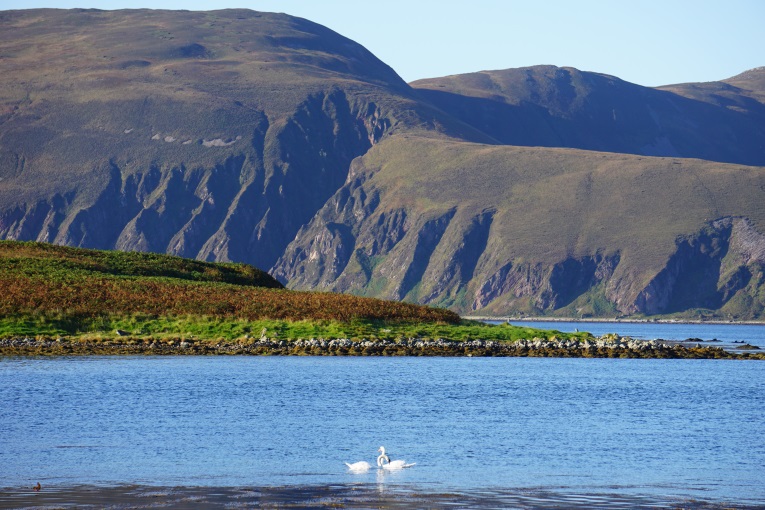
Where else would one rather be when the Sound of Islay is glass-like? This view is from the 12th tee and Islay is across the way.
Ardfin is a big course. It ambles across more than 240 acres of Coffey’s estate. There are four long walks from green to tee but each are part of the Arfin experience. The walk from the fourth green to fifth tee is through a copse of trees, seven to eight is through the famed walled garden of the Jura Estate, a stroll along the beach takes one from 11 to 12 and finally a walk over a rushing waterfall from 15 to 16. You won’t scoot around the course in three hours but then again if you are in a hurry and uninterested in the beauty of the Isle, why come? Crucially, Coffey is an ardent walker and there shall be no carts (or cart paths) to mar the experience.
The first hole starts on the south side of the estate and climbs uphill. The eighteenth heads uphill as well and finishes some 600 yards west of the first tee. In all of golf, the author can’t think of opening and closing hole that both climb uphill to such degree. In between, Harrison takes the golfer on a stroll across southwest Jura. That the two holes don’t finish near each other seems appropriate. Why should the golfer feel like a hamster in a wheel beginning and ending at the same place? The golfer yearns to explore the property and that’s what occurs.
The photographs throughout this course profile are self-explanatory in depicting the beauty of the place. Words are unlikely to capture its grandeur. Some might prefer the sand scape at Tara Iti is or the rolling dunes of Sand Hills or the majestic mountains at Banff Springs. It is fair, though, when someone mentions Cypress Point and the conversation veers down the path of the world’s most beautiful spots for golf that you ask, ‘Have you seen Ardfin?’
Of course, the peril of great beauty is that it can divert the conversation from other meaningful topics. While everyone is fawning over Ardfin’s breathtaking environment, the author has yet heard mention of the green complexes. Intermediate in size and averaging 4,446 square feet, they are exceptional and praiseworthy. They range nicely in size from the tiny 2,800 square foot eighth green to the almost 6,800 square foot seventh. There are three forced carry approaches at non-one shotters (a flick pitch over a ravine at eight, traversing a wetland at eleven and over a creek at thirteen). By and large, short grass feeds onto all the greens, lending the course the flexibility to play in all wind conditions. Some greens are situated on knobs, others in a field. The interior contouring is bold to the point where speeds will hopefully never exceed ‘9’ on the stimp meter.
The task of presenting the course falls to Green Keeper Simon Crawford and his crew. At the time of construction, one of the Sol workers knew Crawford, who was working on a course in Barbados. Since he and his wife are from Islay and wanted to return, the opportunity turned into a win-win. As a past champion at the Machrie, Crawford brings the eye of a player to his role. He arrived shortly after the fescue fairways had been planted and has handled the overseeding with fescue-fine rye mix. Top dressing is frequent. With the course now open, Crawford and his men are making refinements such as thinning the roughs and trimming back the fescues around the fairway side of some bunkers.
Throughout the laborious construction process, Harrison would muse what a dunescape would be like as opposed to the clifftop setting. Ultimately, he decided he preferred the rocky setting as he knew, given the variety of the landscape, the course would have an immediate beauty and sense of maturity. None of the British greats, Old Tom Morris, Horace Hutchison, Harry Colt or Sir Guy Campbell built in a medium like Ardfin’s. They availed themselves of sandy sites which were abundant; working in rock was both impractical and nonsensical back then. However, as man has built courses around the world, drainage technology has evolved to where new possibilities exist.
In certain respects, what Harrison and team fashioned along this rocky coast is a stand alone achievement in Scotland. Certainly, the course doesn’t remind one of any other in the home of golf. With Coffey’s unflinching commitment, the best of technology and design was brought to bear and something splendidly unique emerged. Still, the time-honored design themes of width off the tee, playing angles, interesting hazards and rolling greens are as evident here as on a sandy course by one of the Grand Masters. See if you agree.
Holes to Note
First hole, 435 yards; The expression ‘a gentle handshake’ cuts both ways. Ease into the round and the golfer is happy but make a bogey on the shortish openers at Royal Dornoch or North Berwick and the day becomes a bit longer. Conversely, bogey a tough opener like Machrihanish or Muirfield and the author thinks, ‘no harm no foul.’ The stout uphill opener at Ardfin falls in the later camp. It’s a good thing the practice field is nearby.
Second hole, 205 yards; Countless one shotters around the globe play from high point to high point across a depression. What standouts from others with those same general characteristics? A great green like the ninth at Yale? Absolutely, but surely a fundamental part of the answer is the setting and the scope of the natural hazards. The photographs below need no amplification and it is worth noting that the sight of the ball taking the high right slope and bounding left and onto the putting surface is one of the day’s highlights. So what? The traveler comes here to experience something different and, well, that happens! Every golfer the author has seen play this hole reached for his iPhone.

The thrill of hitting over a crevasse cannot be overstated. Nor can it be imagined until you stand on the tee and do it.

Importantly, lots of green grass exists between the green and the craggy cliff so that the hole functions well in all winds.
Third hole, 350 yards; Ardfin’s pacing is excellent. Tough holes (first, seventh, tenth, fifteenth) invariably have something easier (third, fifth, ninth, sixteenth) spliced into the mix nearby. Played more than once, this short two shotter instantly engenders respect due to its ever narrowing fairway. More variance of club selection off the tee occurs here than any other two shotter on the course with anything from a six iron to a driver being commonplace. The approach is one of the most fun on the course and a golfer never tires of figuring out how to use the sloping ground to work a ball close.

A lesser architect might have elevated the tees to provide perfect visuals of the ever narrowing third fairway. Thankfully, Harrison appreciates the merit of not giving too much away.
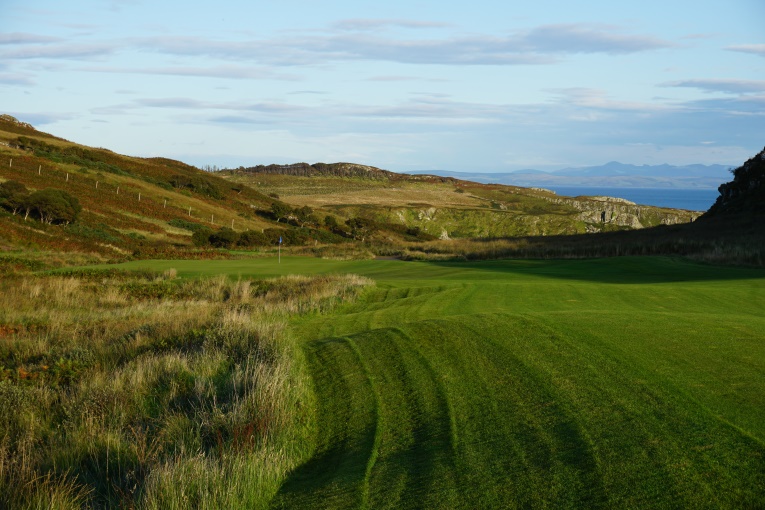
The Craig Mhor Burn is in front of the green and swings left and around the side and back. The high right to low left tilt of the land was perfectly captured …
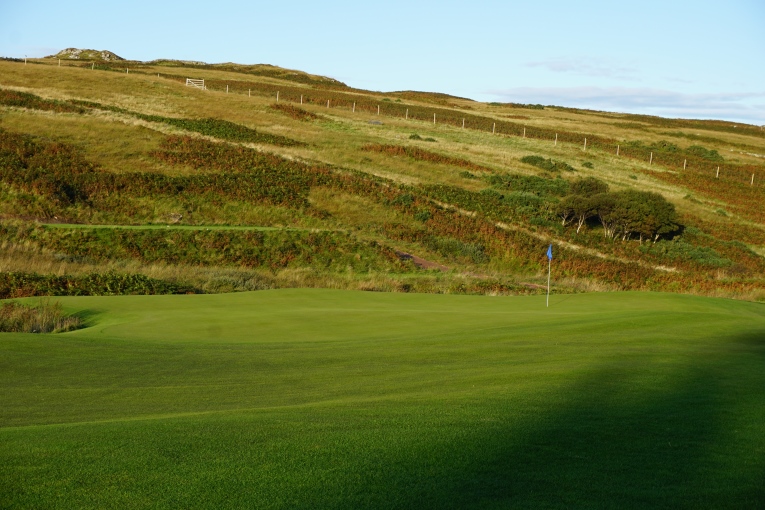
… in the hole’s design. As seen from the right, the fairway spills onto the open green, which continues the natural grade of the ground and cascades left.
Fourth hole, 545 yards; Harrison uses the length of a three shotter to gracefully climb uphill, here and at the Home hole. In both cases, the tee ball is deceiving in that gobs of fairway are hidden from view. Both tee balls are among the more important of the day because the subsequent forced-carry becomes problematic without a good one. Here, a forty-five yard band of wetland must be negotiated on one’s second in order to set up a short iron approach.
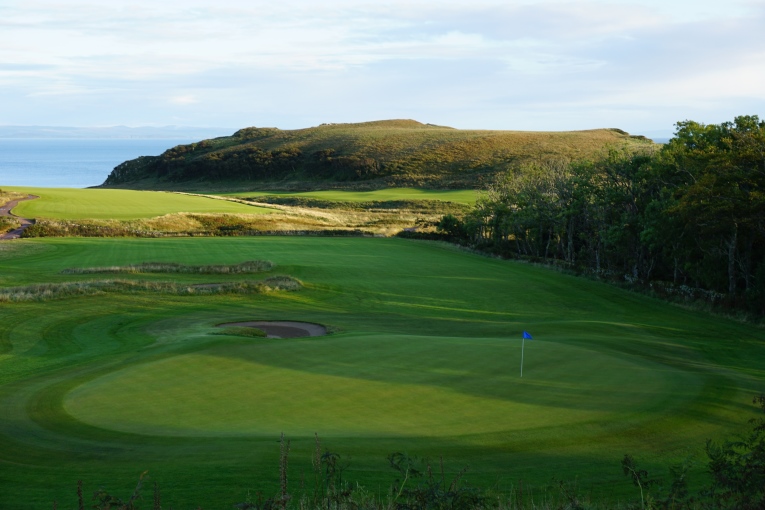
As seen from behind, shot after shot, there is always something to be gained by playing the angles at Ardfin. In this case, the best pitch into the green comes from hitting one’s second shot across the wetland and toward the stonewall.
Fifth hole, 300 yards; The design challenge at Ardfin was not about making the golf exciting; that was a given in the right architect’s hands. The challenge was to make it fun for a range of talent. For instance, on the prior hole the golfer is confronted with a blind uphill carry off the tee and then a forced carry over a wetland for his second. Conscious of not overwhelming the golfer, Harrison cleared an immense, nearly five acre parcel of land and created a shared fairway for the fifth and sixth holes. This is Ardfin’s version of the Elysian Fields and it stretches almost 100 yards side to side. While most architects would have placed something in this expanse of green, Harrison, in a design master stroke, left well enough alone.

The golfer will second guess himself for mindlessly accepting the architect’s invitation to drive left where he has to carry the hole’s sole man-made hazard. Balls played from the left section of the fairway carry the hazard only to gather in a depression in the green from where they are whisked away from left hole locations.

As seen from behind, the stone wall, center left depression, and left greenside bunker highlight how the best holes are often the simplest. This represents the most inland point for golf on the estate and this perspective looking down across all the tightly maintained turf is one of the author’s very favorite views on a course full of long views.
Sixth hole, 410 yards; A perfect golf hole that challenges the tiger while being playable for the other 98%. A newly constructed low lying stonewall intrudes into the fairway and forms a corner in the vicinity where tee balls land. Carry the far wall and life is grand as the golfer delights in a huge forward kick toward the green. Or just scoot past it and still enjoy an optimal angle into the green. For the rest, they have a 95 yard wide fairway (!) to which to hit. True, the more they veer left, the crummier the approach angle but short grass is your friend at Ardfin.

Ardfin’s intermediate size greens don’t tolerate sloppy tactics. With rough left and tight grass right, the 3,600 square foot knob green is one of the more vexing targets to hit.

As seen from behind, that little crease in the green catches an adequate approach and funnels it off the putting surface. Chipping and executing other fiddly little shots around the green determine one’s success as the golfer is unlikely to hit his usual amount of greens in regulation, given the wind and green sizes.
Seventh hole, 460 yards; The play is toward the elevated outside of the dogleg – or is it? Some players seek the high ground off the tee in order to see the rolling green below but others pursue the shorter route home that leaves a blind approach. It amounts to the author’s favorite hole on the front. Why? Because it begs for experimentation. Nothing would be more fun than taking a small bag of balls and standing in different parts of the fairway and trying to execute the right approach to the fallaway green. The dazzling views accentuate everything but the fact is that the golfer is in the midst of a run of holes where the actual shots he is asked to consider are immensely appealing in and of themselves.

Conversely, those that hug the inside of the fairway must contend with the uncertainty that comes from hoisting a blind approach up and over this handsomely clad bank.
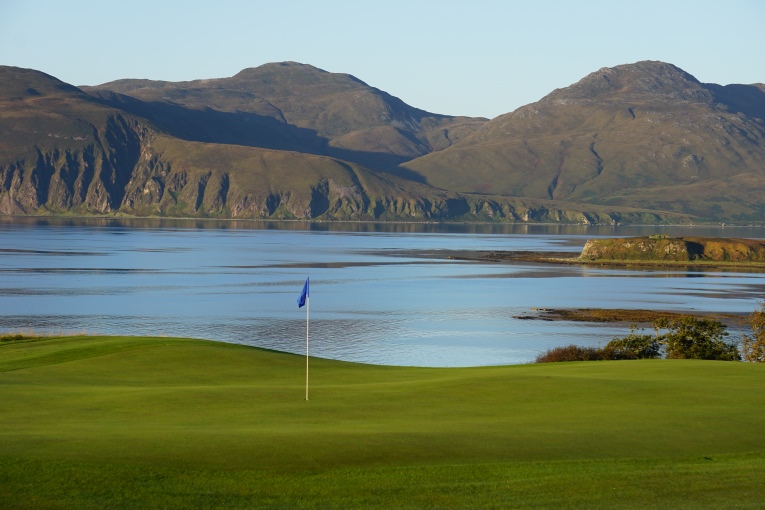
As seen from the right, the 7th green follows the natural grade of the land and slides downhill away from the golfer. This is one of five bunkerless greens on the course.
Eighth hole, 320 yards; The course that we play today was the fourteenth iteration of which Harrison devised. In order for this routing to become the one that Harrison ultimately submitted to Coffey for approval, two major obstacles needed to be resolved. This portion of the property had to to house a hole and the Home hole needed to not be too steep for good golf. Both required extensive land shaping and turned out better than Harrison could have possibly hoped.

This is one of the more nervy tee shots of the day, though it is helpful to know that additional fairway is found behind the hillside that was exposed during construction.
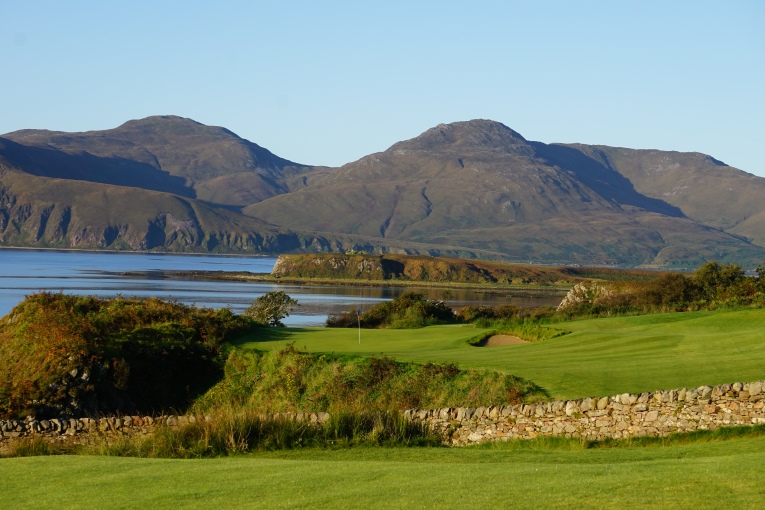
Harrison went from being concerned that a hole would work here to nominating this approach as his single favorite shot on the course.

The long narrow 2,800 square foot green only works at the end of a modest length hole; peril short and left would overwhelm too many players too often if it was found on a longer hole.
Ninth hole, 295 yards; Ardfin features 29 bunkers and it doesn’t need even one more. Why? As we see at three of the next four holes, various stones and boulders are found within the fairways to enliven the proceedings. Here, a linear array of archeologically protected stones were perfectly incorporated into the landing zone. Whether the golfer attempts to carry them is weather dependent. Numerous interesting playing angles and options exist on this sub-300 yard hole.
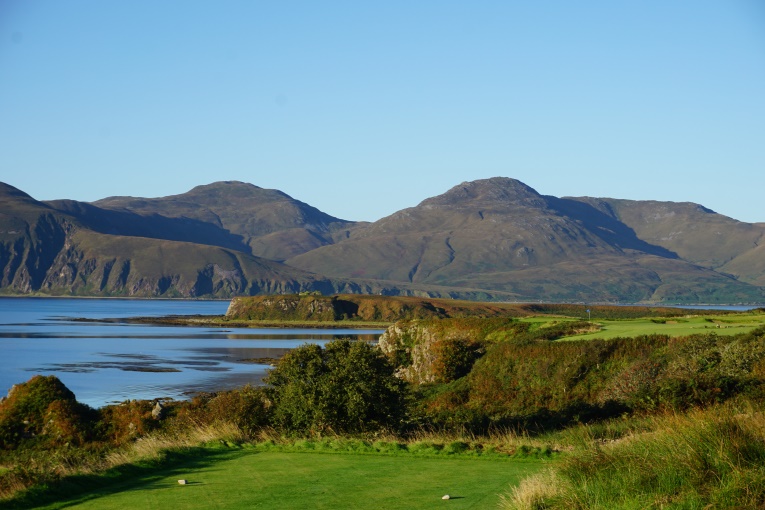
Similar to the 9th at Cypress Point, the golfer decides on the tee how best to attack an elongated green that is almost perpendicular to the fairway.
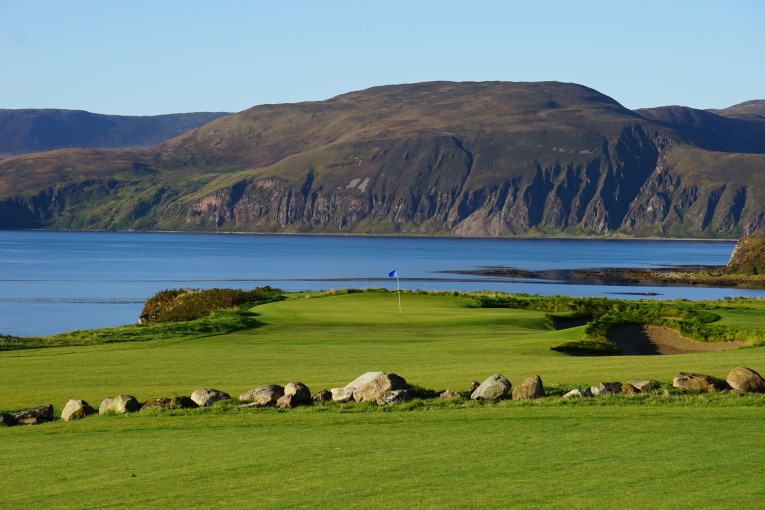
Staying short and right of the stones leaves this most appealing view down the length of the green. Certainly, the man who can flatten the trajectory of his pitch enjoys an advantage.

For the tiger that entertains aspirations of driving the green, this bunker 40 yards right of the green is his aiming bunker. Let’s face it though …
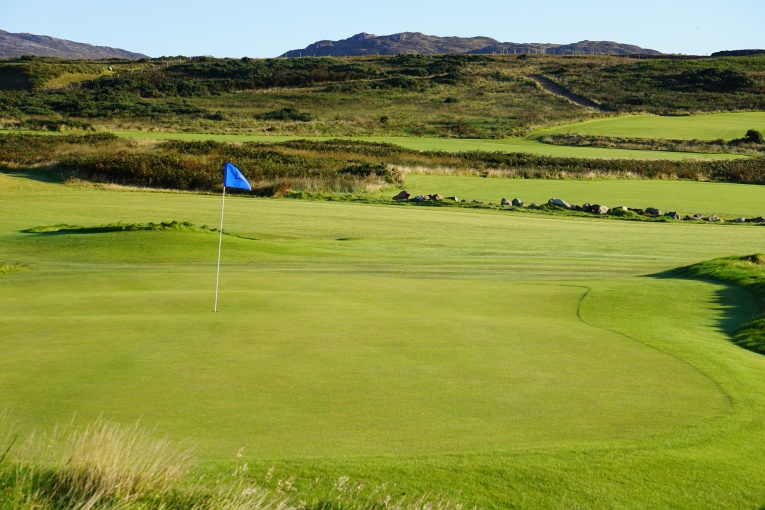
… the 3,466 square foot green isn’t a very big target. Given Ardfin’s limited rounds, Harrison took full advantage of the opportunity to throw several small greens into the mix of the sort that can’t be built at busy resorts.
Tenth hole, 175 yards; The golfer faces one of the game’s most visually arresting shots. From a playability perspective, the hole is made by what the golfer doesn’t see: an area of short grass bigger than the green to the right. This means that a bogey is always achievable, which may seem like an odd statement but there is no such thing as a great hole where a bogey can’t be earned by someone who employs non-greedy tactics. Similar to sixteen at Cypress Point, when the golfer pulls off a shot that finds the green, the indelible moment moves to the front of the class in the golfer’s mind.
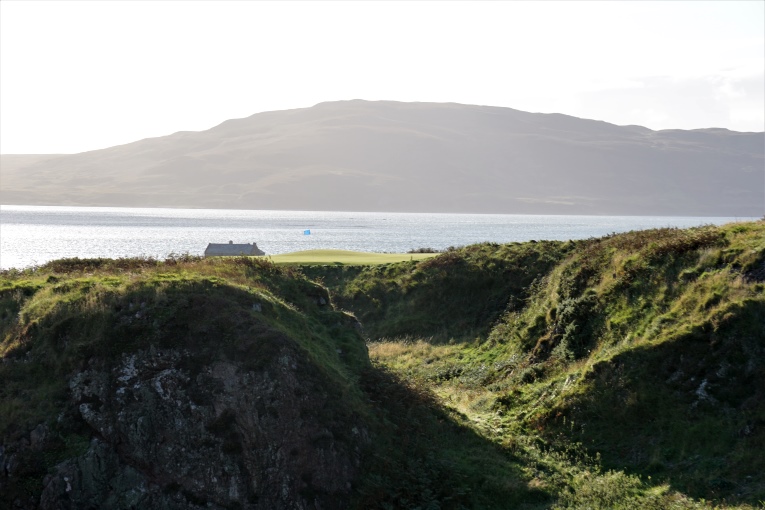
The coastal erosion over the centuries has left behind canyons, whose 3-D qualities are other worldly.
Eleventh hole, 390 yards; Though this hole transports the golfer to the shore, Ardfin is a clifftop top course rather than a links. Similar to Pebble Beach, its fairways attractively flow as opposed to being lumpy-bumpy like a links. Still, slight adjustments to one’s stance/set-up are required throughout the round. Take this fairway as a prime example. The tiger line is left toward the distant flag. From the left third of the fairway, the golfer is afforded a reasonably level stance to take on the forced carry approach. As the golfer steers his tee ball cautiously to the right, the likelihood of gaining a good stance is replaced by one whereby he will receive some sort of a slightly downhill stance. This becomes problematic and compounds the uncertainty of carrying the wetland. Visually stunning, the eleventh is another example of a hole that only reveals its secrets after multiple rounds.

One benefit of leaving such rock formations behind as central hazards? They don’t need to be nursed after heavy rain like a bunker.
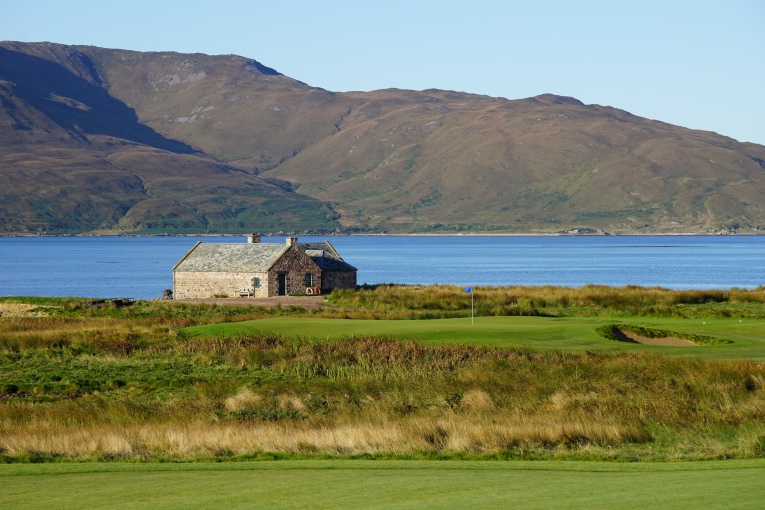
The postcard perfect approach to the 11th highlights an important fact: the only thing better than playing beside a large body of water is playing beside one that has land in the distance. The best way to appreciate what the mountains of Islay add to the playing ambience is to imagine the scene above without them.
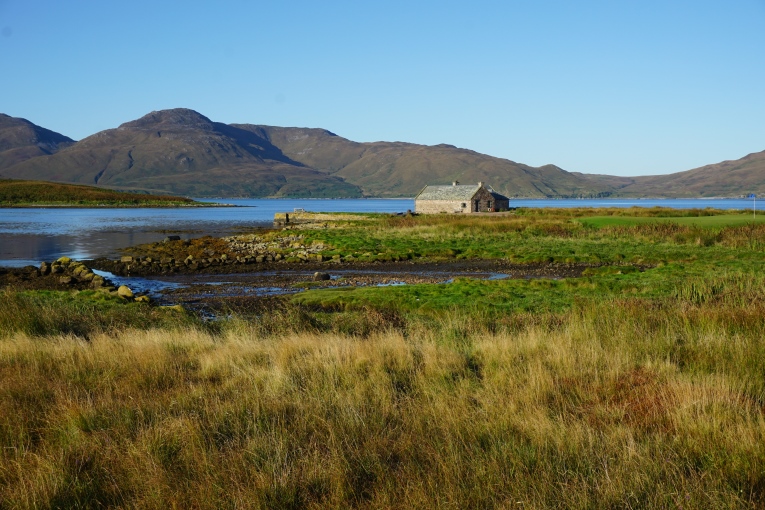
Forty yards short and left of the 11th green is a rocky port that dates back to the Vikings. The entire area near it is protected and made building the green complex a challenge.
Twelfth hole, 205 yards; Aware of some long green to tee walks, Harrison opted to place the tee here a few paces off the eleventh green, rendering a nearly straight approach down the axis of the course’s longest green at 42 paces. The hole measured 185 yards but Harrison is quick to point out that Mrs. Coffey thought a tee out past the Boat House might provide a more exciting moment. And guess what? She was right. Apart from the heightened sense of drama that comes from hitting over the sound, another benefit of the back left tee is the stark change of direction. Starting at the seventh, play generally progresses in a north-westerly direction up the coast. The key word is ‘generally.’ Mercifully, this is not a linear coastline and as anyone knows who has played in wind, a mere ten degree change in direction makes a meaningful impact on club selection. As the golfer plays this eight hole stretch, the two one shotters offer abrupt shifts in direction. The approach to the ninth forms an eighty degree angle with the one shot tenth and the twelfth from this new back tee makes it akin to hitting inland, again a mighty shift in direction from the holes on either side of it. Other holes like the eleventh and fourteenth bend twenty degrees within their own playing corridors, which is again significant. Like the world’s great routings at Muirfield and Portmarnock, the golfer is kept on his toes regarding judgement of wind and club selection.
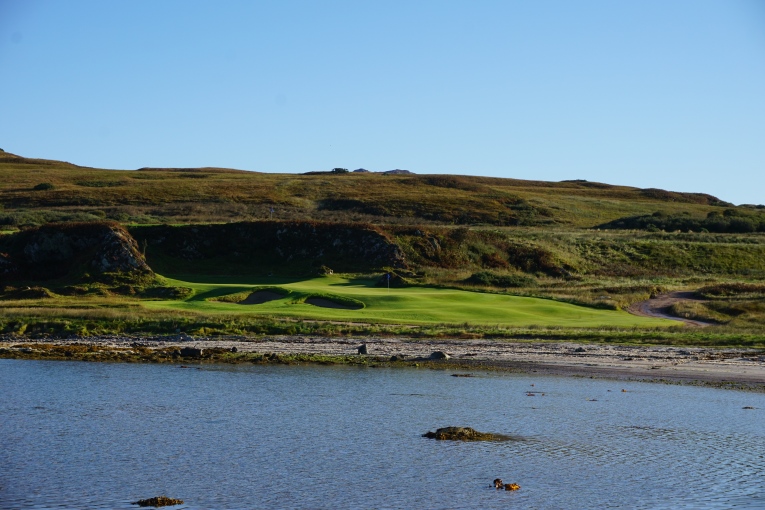
After fortifying the spirit at the Boat House, the golfer walks over to the far edge of the spit of land to face this shot over a nook in the sound.
Thirteenth hole, 380 yards; An architect’s job is to incorporate a site’s natural features into the best possible golf. What happens when there is an abundance of features? Is there such a thing as too much chocolate?! Here, two streams forty yards apart come rushing off the hillside and into the sound. Harrison placed the green between them. Why not? The hole is short enough to accommodate a front and back hazard. Yet, this is Jura and greater allowance must to be made for the elements. Early play indicated that front and back hazards could crush the golfer on the (albeit rare) days when the hole plays against the wind. What is scary is that Coffey is having Harrison immediately remedy the situation. Similar to instituting the steps to increase/improve drainage in 2015/2016, Coffey’s relentless will to get things not just right but perfect means there is no telling what heights Ardfin will ultimately achieve in world golf. With the golf matching the scenery, it is a world beater.

Placing the tee 30 yards behind to the stone building was inspired. The Heritage-listed building is where the sheep were corralled before being loaded onto boats.
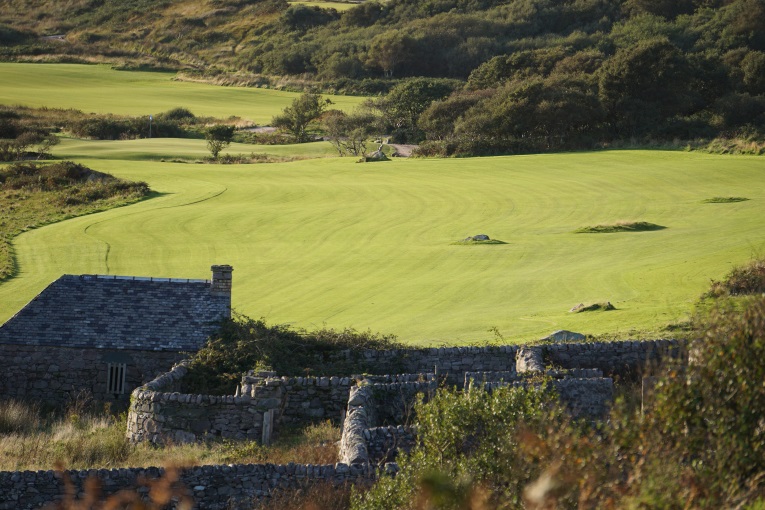
As seen from a dune above, the 13th fairway is attractively littered with random rock outcroppings that serve as central hazards.
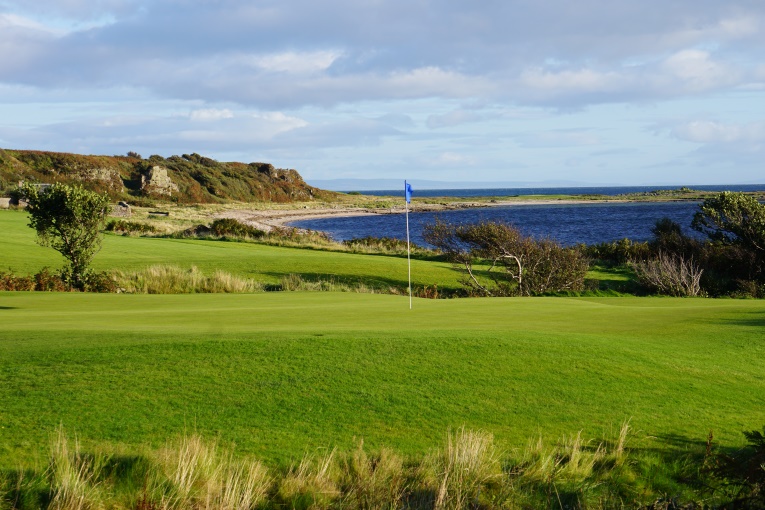
The view from behind is cautionary with water hazards both front and back that rob the hole of the required flexibility to play well in all winds. Action is being taken.
Fourteenth hole, 410 yards; The beauty of the last eight holes might be the biggest takeaway from a round here. For someone like the author who loves the Peter May Hebrides books, it seems like a dream come true. Yet, crucially, the golf keeps pace with the beauty. This tee is placed close to the shore guaranteeing that the shoreline’s crescent bend to the left is put to maximum strategic effect. The tiger may even hang his tee ball out over the water for most of the journey in hopes of finding the broad expanse of fairway that flairs left on the far side. Surprisingly small, less than 3,000 square feet, the green actually plays big as the high ground to the right kicks plenty of balls onto the putting surface. The green placement is as far left as was allowed and the subsequent green to tee walk is the better for that.
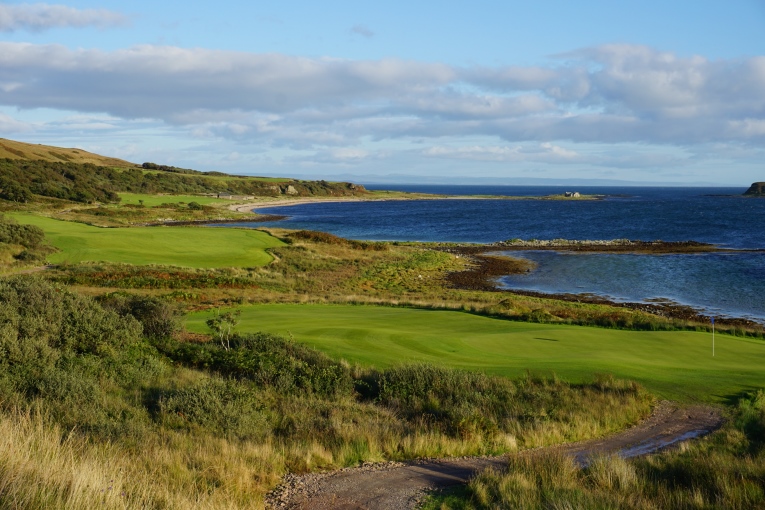
Looking back down the shoreline to the Boat House and beyond, the golfer can’t help but reflect on the coastal run of holes he has just completed.
Fifteenth hole, 435 yards; A well-conceived hole on tricky land, the 80 yard (!) wide fairway provides cheer on this tough uphiller. As always, there is a preferred section and the golfer is best served by playing down the right where he gains a more level stance and enjoys a good view of the green. The land just short of the green was massaged to both hide the green and shunt balls right that come in from the left. As always where severe trouble lurks along one side (in this case, the right), Harrison provides short grass and friendly bounces on the other side.

This bunker on the inside of the elbow at 15 joins one at 17 as the biggest expanse of sand on the course. Small, revetted pots would be too formal and do the broad, sweeping landscape an injustice.
Sixteenth hole, 505 yards; Early feedback has this ½ par hole as the favorite of many – and for just reason. The two most crucial components to great golf are here in techni-color: beauty + strategy. The tiger tries to squeeze his tee ball between a bunker right and rock covered mounds left. If successful, he finds himself within 230 yards from the green amid another series of decisions. The golfer is asked to think and when he isn’t thinking or playing, he is enveloped in a setting that generates superlatives. Hard to imagine that the game offers many better moments. One golfer compares it to the exhilaration found in playing the fifth at New South Wales GC south of Sydney.
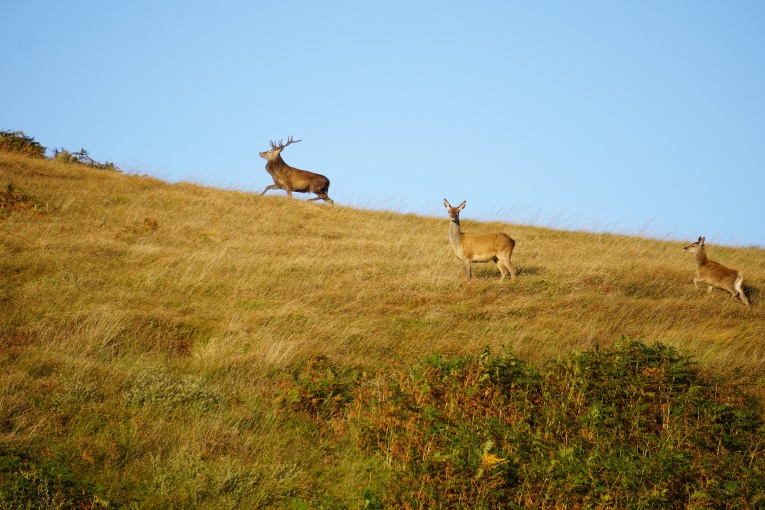
Don’t let the spectators high on the hill left of 16 put you off your game. Rains on this slope never reach the fairway thanks to the ditch system that was put in place.
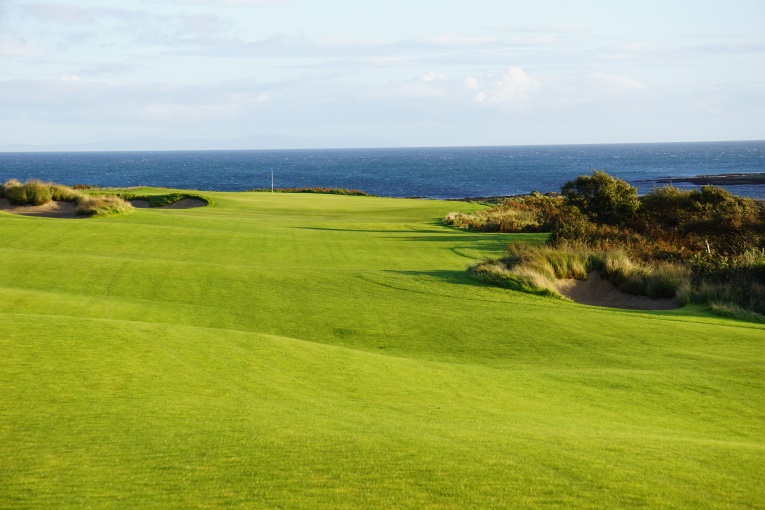
The fairway narrows so it is indeed a courageous shot that reaches the putting surface. Note the green’s clean lines and how they do nothing to disturb the setting.

The spoiled rotten golfer might be numb to Ardfin’s beauty by the time he approaches the 16th green.

Claig Castle was built on the above island in the 16th century to maintain control of the Sound of Islay. Today’s golfer can use the restored Boat House in the foreground to restore confidence before teeing off the 12th.
Seventeenth hole, 460 yards; There is no sight of the flag or any suggestions. Nothing is given away at the tee, an attribute the author always admires. The man who can move the golf ball the farthest from the tee does gain an advantage if he can get to the other side of the valley wall, where he will be at a similar elevation as the green. Those shorter off the tee – or when the wind is against – suffer more muddled optics.

One of the author’s favorite approach shots comes at the penultimate hole with Brosdale as the immediate backdrop and Arran (home of the 12 hole Shiskine) in the distance.
Eighteenth hole, 530 yards; From an accomplishment point of view, this hole ranks near the top for Harrison. If he couldn’t fashion a hole here, everything before would be jeopardized. Yes, the side-slope was dispiritingly steep but the way the fairway stair-steps up could not have turned out better. Look at the photograph below: doesn’t the Home hole (and the whole course for that matter) appear mature? The rich textures of the heather and fescue roughs complement the maintained surfaces and the course seems like it has been a part of the landscape for yonks.

Similar to the 4th at Bethpage Black, the Home hole for most golfers is a three step process. From the opening tee shot to the closing hole, the golfer is fully engaged at Ardfin.
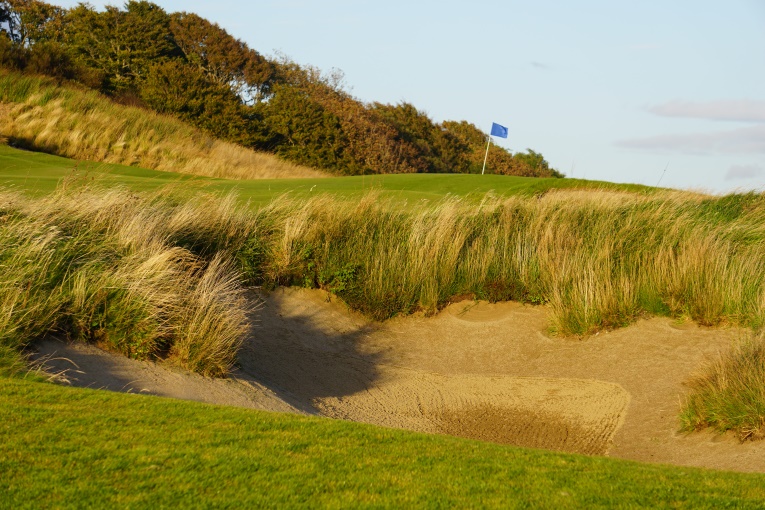
When the wind is helpful and behind, this bunker 30 yards short gets a work out from those that come up a smidge short.
What a walk, what a course! During the round, you hit over a crevasse, play beside babbling brooks, face daunting moments, meander through a secret garden, stroll along cliff tops, play several tee balls over the shoreline, walk along the beach, cross a waterfall and gaze over the Boat House past the ruins of a 16th century castle. All this occurs beneath the imposing mountains of Islay which loom across the sound. Suffice to say, Ardfin is one of the game’s incomparable settings.
Happily, the golf is a match for the scenery. This 6,800 yard course can be brawny and on certain days dismantle a golfer faster than Carnoustie. That’s why hiring Harrison was such a shrewd move by Coffey. Harrison’s favorite golf is fun golf and that wasn’t going to occur here by accident. That something so graceful could be fashioned from something so harsh is an incredible testament to all involved. Modify too much and the property would appear neutered; too little and the golf becomes insufferable. After a few planned tweak included thinning the roughs, the desired balance will have been spectacularly (definition: strikingly, sensationally) achieved.
Two takeaways on the golf: five two shot holes measure between 295 yards and 380 yards. Separately and cumulatively, they are w-o-n-d-e-r-f-u-l. Similar to several exemplar designs (e.g. Pine Valley, Oakmont, Merion, Kingston Heath), these sub-400 yarders help elevate the course into the top echelon as they require the golfer both to execute and play tactically. Such length holes are manageable for a wide range of players even in the wind but Ardfin’s holes (e.g. the third, fifth, eighth, ninth, and thirteenth) can quickly mete out some harsh penalties. It’s great to see such holes on the menu as the thinking golfer can keep pace or even best the modern power player.
Additionally, though there are only three one-shotters, their challenges create memories for a lifetime. Any one hole would be a standout but to find a trio is a wonder and highlights the diverse nature of Ardfin’s irregular coastline. All three represent mostly aerial golf but that never stopped the author from slobbering over the sixteenth at Cypress and the ninth at Yale.
At the time of this writing, the Coffeys are desirous of showcasing this special part of the world to interested folks. Perhaps a score or two of people will have access to the course on given days in the golf season. A 200+ year old stone farm complex is being expanded and enhanced as this profile is published in October, 2017. When complete, and given the immaculate attention to detail everywhere else at Ardfin, it will rival the accommodations at Skibo Castle and Loch Lomond. A treatise needs to be done on why lux accommodations are the cat’s meow in Scotland but the fact is, they are.
So … how to get here? One fine way is to fly into Glasgow, rent a car and drive for 2 1/2 hours to Tayvallich and catch a rib across the Sound of Jura. The 45 minute passing is an absolute highlight, not a penance. Best yet, the harbor at Jura is at the foot of both the cozy Jura Hotel and the world famed distillery.

What a greeting on the southeastern end of the island – what else does the traveling golfer need?! Harrison stayed in this hotel for 153 nights during the build.
Once on the isle, a range of activities exist. Stag stalking might be the supreme way to gain an appreciation of the island’s environment. Hiking and biking are other grand ways to explore. Otherwise, a road extends up the east coast where one gorgeous scene unfolds after another. The Paps of Jura refer to the three 2,500 foot mountains that dominate the island’s mid-section. They are sufficiently tall to be seen from Northern Ireland and the famous Isle of Jura Fell Race each May sends runners up and down all three.

Quaint coves and pockets exist up the coast road. One might head north in hopes of gaining a glimpse of Barnhill, where Orwell wrote 1984.

Year-around Jura inhabitants total less than 260 but they possess a quick smile and a delicious sense of humor.

Life moves at its own relaxed pace on Jura; just ask this Miniature Shetland pony to hurry up and you’ll know.
There is timeless beauty to the rugged landscape, where elemental forces dominate. The golfer senses that and yearns to reestablish a close connection with nature. He is drawn to Ardfin like few places on earth. During the author’s four day visit, he saw cows, stags, an otter, one peacock, seals, goats, sheep, red deer, dogs, swans, golden eagles and the Miniature Shetland pony above.
The thing about this young course is that it doesn’t feel young. Whether admiring the stone Viking port or gazing at the 16th century castle or appreciating the restoration of the old farmhouse, the golfer witnesses history. Beauty here is so prevalent at every turn that the game of golf takes on heightened significance versus a course where Mother Nature was more stingy. The hazards are more compelling at Ardfin, so the golf is also. The sense of triumph that can occur here is almost unrivaled. George Orwell must have been a golfer because it is true: some courses are more equal than others.




